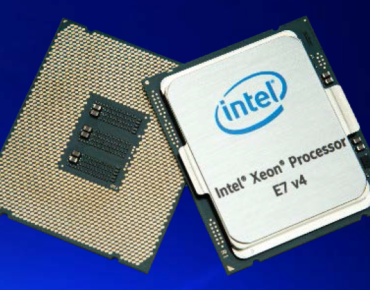Intel Xeon E7 Balloons In-memory Capacity, Targets Real-Time Analytics

Who crunches more data faster, wins. It’s this drive that cuts through and clarifies the essence of the evolutionary spirit in the computer industry, the dual desire to get to real time with bigger and bigger chunks of data. The locomotive: HPC technologies adapted to enterprise mission-critical data analytics.
With its memory capacity of up to 24TB in an eight-socket system, the largest capacity in the industry according to Intel, the new Xeon processor E7-8800/4800 v4 allows massive datasets to be stored in memory in support of real-time data analytics applications. The processor family offers traditional four- and eight-socket support and is designed for configurations up to 256 sockets via third-party node controllers. It is used in OEM system designs that currently feature up to 64 sockets.
The result: up to 2X more analytic query performance, according to Pat Buddenbaum, general manager of Intel's Enterprise IT Solutions. He emphasized that the new processor is targeting the real-time, mission critical space across multiple industries and applications, including fraud and intrusion detection, power grid outage response, high volume trading and customer engagement.
“Data in the cloud today is mostly generated by people,” Buddenbaum told EnterpriseTech, “whether by transactions that we do with online purchases, whether in social media, all of those represent people in position to generate the data. But increasingly we see the role of IoT, these machines, becoming more integrated into these systems. We believe data will rapidly outpace what we’re seeing today, and we believe the analytics of the data will really define the winners of the future.”
The focus is “how to get better yields on the product,” Buddenbaum said, “how do you improve your network intrusion detection for your IT organization; or if it’s customer engagement, how do you better retain your customer base, how do you reach out and personalize the experience. We see all of that being driven by data analytics and the pervasive usage of it.”
The announcement of the Xeon E7 family, built on the high-end “Brickland” server platform based on Intel’s Ivy Bridge-EX processor, follows Intel’s March 31 announcement of the Xeon “Broadwell” E5-2600 v4. The E7 family supports scale-up architectures (adding more resources to a single node and a single system image) in which high core count and very high memory (>1TB) are required. E5 processors, on the other hand, support scale-out architectures (adding more nodes to scale performance) with a distributed processing approach for scale-out Apache Hadoop deployments, HPC and machine learning.
Beyond memory capacity and throughput, Intel said the Xeon E7-8800/4800 v4 also incorporates more than 70 RAS (reliability, availability, serviceability) features for the high availability requirements of mission critical workloads. They include error recovery mechanisms, such as memory mirroring, that don’t drive up system-wide memory requirements.
Patrick Moorhead, president of analyst firm Moor Insights & Strategy, told EnterpriseTech that Xeon has become Intel’s workhorse for scale-up enterprise analytics since dialing back Itanium years ago.
“It took a while for Intel to get to the memory addressability, RAS, and the kind of performance and features needed in those spaces, but they’re there now,” he said.
“Intel is tired of playing second fiddle to IBM and Oracle in big iron, scale-up areas and are spending tons of R&D in this space,” said Moor. “Intel’s play here is to drive sufficient-enough levels of performance and RAS, but leverage their immense scale they have with Xeon. Intel controls 95 percent of the server market and that gives them cost advantages not just in the CPU but the platform. HPE has done the most work in this high-end Xeon space with Integrity Superdome X Server.”
Intel said the E7 v4 processor family has built-in security features that provide up to 70 percent more encryption performance per core4, enabling protection of a growing amount of data with less performance impact. Another feature is Intel’s OS Guard, which now includes “supervisor mode access protection” for more control over user access to sensitive data.
The E7 v4 also has enhanced hardware-assisted virtualization, Intel said, that allows IT to virtualize mission-critical enterprise workloads and move them into cloud-scale environments. This lowers latencies when entering and exiting virtual machines (VMs), fewer VM interrupts via posted interrupts, and less overhead in fault-tolerant environments with page modification logging.
For resource orchestration and service level management across multiple applications, the E7 includes telemetry features, such as Intel Resource Director Technology, designed to provide visibility and control over shared platform resources for scheduling, load balancing and workload migration across virtual machines.











